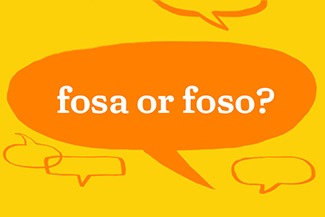Putting our best foot forward (or even our second-best one) let’s turn to another pair of Spanish nouns that are nearly identical in form, though not in ending or gender, and which have very different meanings. These are calzada (feminine) and calzado (masculine).
Starting with calzada, you can listen to its pronunciation here:
La calzada is that part of a street which is bordered by pavements or the section of roadway used by vehicles. In other words, it’s the road, or sometimes the carriageway (especially when talking about motorways or dual carriageways):
El autocar se salió de la calzada en una curva.
The coach came off the road on a bend.
El turismo que conducía invadió la calzada contraria al tiempo que pasaba un camión.
The car he was driving went over onto the wrong side of the road just as a lorry was passing.
El resto de la calzada se encuentra en buen estado.
The rest of the road is in good condition.
En el punto en que se acaba la doble calzada, se pueden producir retenciones.
There may be tailbacks or delays where the dual carriageway ends.
Se cerrará a la circulación la calzada en dirección norte.
The northbound carriageway will be closed to traffic.
Moving on to calzado, you can listen to its pronunciation here:
Calzado is a generic term for protective foot coverings, whether these are laced-up shoes, slip-ons, boots, sandals or trainers/sneakers…: footwear in other words:
los sectores textil y del calzado
the textile and footwear sectors
una nueva línea de calzado para baloncesto, balonmano y entrenamiento
a new line of footwear for basketball, handball and training
los comercios, almacenes de ropa y tiendas de calzado
businesses, clothing stores and shoe shops
el acto de abrillantar el calzado
the act of polishing shoes
DID YOU KNOW?
Related to the noun calzado is the verb calzar, with its reflexive calzarse and past participle/adjective calzado) Not surprisingly these are connected with putting on or wearing footwear:
Le entregaron al Pontífice 2 000 pares de zapatos para calzar a los pobres.
They gave the Pope 2,000 pairs of shoes to provide footwear for the poor.
Se sentó en la cama y se calzó las zapatillas.
She sat on the bed and put on her slippers.
un anciano calzado con unos zapatos burdos
an old man wearing coarse shoes
Apareció el abogado, calzados los pies en zapatillas forradas de piel.
The lawyer appeared, with his feet shod in fur-lined slippers or with fur-lined slippers on his feet.
Hardly a step away from the words above is un calcetín, a knitted garment covering the foot and often part of the leg. What is it? A sock, of course.
Perdonadme, pero he de quitarme los calcetines.
Forgive me, but I must take my socks off.
Un día bajó a la calle con un calcetín de color azul y otro de color marrón.
One day he went down to the street wearing one blue sock and one brown one.
To polish up your knowledge of some more similar-looking Spanish nouns with different meanings, come back next week.



